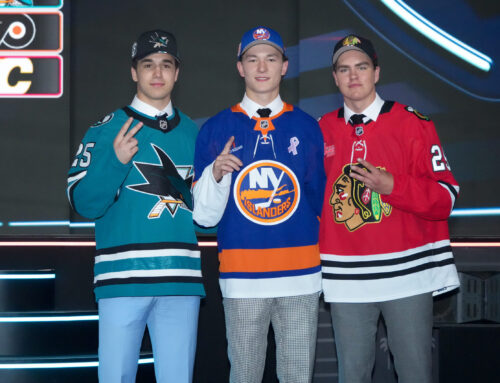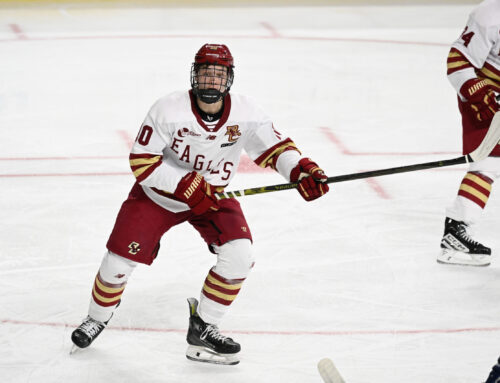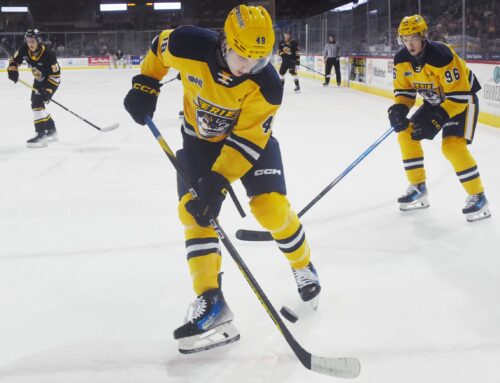Welcome back to The Journey, where we track the development of prospects as they excel in junior, make the NHL, and push towards stardom.
***
Inspired by Thomas Harley's incredible break out campaign in 2023-24, this is the second instalment in a series highlighting young players (under 24) around the league who made a significant mark on their respective teams this year, especially in terms of playdriving (relCorsiFor), playmaking/involvement (IPP), and overall value added (xWAR, xGAR).
Catch Part One here.
This week, we will look at the league's next eleven teams by alphabetical order.
At a Glance
Detroit: Simon Edvinsson, 21
Edmonton: Dylan Holloway, 22
Florida: Anton Lundell, 22
Los Angeles: Arthur Kaliyev, 22 (HM: Brandt Clarke)
Minnesota: Marco Rossi, 22
Montreal: Joshua Roy, 20 (HM: Jordan Harris, 23)
New Jersey: Luke Hughes, 19
Nashville: Luke Evangelista, 22
New York Islanders: None (HM: Noah Dobson, 24)
New York Rangers: Alexis Lafreniere, 22 (HM: Filip Chytil, 24)
Ottawa: Shane Pinto, 23 (HM: Jake Sanderson, 21)
***
Simon Edvinsson played the final 16 games of the 2023-24 campaign with Detroit, working with Jeff Petry on the bottom pair. The Wings have five defenders already signed for next year, and Moritz Seider is an RFA who will be paid big money and locked down long-term. If Shayne Gostisbehere also returns, that makes seven pro defenders already under contract, meaning Edvinsson likely kicks off the year back in Grand Rapids.
Edvinsson looks ready, though. He played a lot over those 16 games, was not that sheltered, and did well, driving play better than his veteran partner, for example, and finishing eighth on the team in xGAR. Two assists do not move the fantasy needle, but the offensive skills and mindset are there. Expect his scoring to slowly increase, as it has his whole career to date, until he is a consistent 50+ point performer with big hits and blocks totals.
***
I wrote about Dylan Holloway, Anton Lundell, and Alexis Lafreniere a couple weeks ago because they were all performing well early on in the playoffs. Given that all three (at the time of writing) are still in the playoffs, let's zoom in on how the second round has gone / is going.
The main frustration with Holloway all along has been that when he does play with the Oilers (he has actually played exactly 100 games for Edmonton now), he typically gets under 10 minutes a night on the fourth line, never getting time beside Connor McDavid or Leon Draisaitl. Well, that has changed so far in the Vancouver series. Holloway has played in the top six for the last few games now, alongside Draisaitl for Games 4 and 5 and Ryan Nugent-Hopkins for Game 3. The results for the Oilers as a team have been subpar, however, and the Holloway-Draisaitl line has been getting blown up against the Canucks, losing out on scoring chances 16-10. Hopefully for Holloway owners, that line sticks together and turns in a stronger performance in Game 6.
***
While Holloway's scoring stalled at two points in Round 1, Lundell has continued to hit the scoresheet regularly. He now has nine points in 11 playoff games, including a goal and an assist to eliminate Boston yesterday. Lundell has mostly toiled in the bottom six but has replaced Sam Bennett at times on the Matthew Tkachuk and Carter Verhaeghe line. He is throwing an uncharacteristic number of hits (almost 2.5/game) and winning a ton of face-offs (53.5% win rate), though his shot rate is down slightly. During the regular season, he drove play well in a fairly prominent offensive role, receiving the sixth-most offensive zone starts on the team.
He is now about 50 games past his Breakout Threshold (BT) and overdue for a step forward offensively. Are we seeing the beginning of that step forward right now in the playoffs?
***
Arthur Kaliyev is easily the biggest surprise on this list. He has declined so hard offensively and been healthy scratched so many times that it is fair to wonder if he is even an NHLer at this point—let alone a fantasy asset. He needs to get out of LA, but can a trade unlock the goal-scoring upside he always had coming up? What went wrong this season?
He broke into the league in his Draft+3 season, then improved on his rookie production in Year Two. But then this year, just as he approached his BT (197 career games), he fell out of favour and took a massive step backwards. More perplexing is that he did quite well over the first quarter of the season, scoring ten points in 17 games with decent power-play exposure and solid shot rates, which has been one of his redeeming graces in fantasy to date. Then he scored only five more points for the rest of the year and spent a good chunk of it watching from the press box.
The perplexing part is that Kaliyev drove play really well in a heavily sheltered role this year—especially when compared to fellow sheltered youngsters Alex Turcotte and Alex Laferriere. He finished 11th on the team in xGAR and had one of the highest relative Corsi For ratings on the team, which gives him a rare "Effective Sheltered Forward" label in the Dobber deployment chart below. Sure, you do not want to have to shelter a player forever, but the underlying stats suggest a young guy who is clearly ready for a more prominent role. But instead, he was repeatedly scratched.

Joe Patarino at Hockey Royalty points to declining proficiency on the PP and his slow skating making him ineffective in transition. Per NHL Edge, Kaliyev is indeed in the bottom half of the league for a variety of skating speed metrics. Something about the Kings' system was not working for Kaliyev this year, and he clearly needs a trade to reinvigorate his career. His shot remains special, but he has a lot of question marks at this point.
For fantasy, I actually see him as a pretty intriguing buy-low player right now. If he lands somewhere, gets some PP time, and hits his BT, the result could be a 30-goal, 50+-point season seemingly out of nowhere. After all, it was not that long ago that Kaliyev was on a star-level trajectory.

***
Marco Rossi just posted a very sustainable-looking 40-point, 82-game campaign. He has room to improve on the power play, but his IPP at even strength was solid (66%). Minnesota is feeding him offensive zone starts, elite linemates, and a fair amount of PP time. He is being somewhat sheltered but doing great with it. The Wild are out from under the combined $15 million dollar dead cap hit of Zach Parise (who retired after the Avalanche were eliminated last night) and Ryan Suter (who helped eliminate them) next year, so this is a young team that will be able to add pieces and improve in a hurry.
Although there were question marks heading into this past year, Rossi has proved that he will be right in the middle of this rising Minnesota tide.
***
One of the youngest players on this list, Joshua Roy looked great for Montreal in a 23-game audition this year. So did Honourable Mention Jordan Harris, but Harris quite a bit less interesting for fantasy purposes. Roy sported a star-level IPP (75) and finished 10th on the Canadiens in xGAR, which he obtained through balanced offensive- and defensive-zone impacts and some proficiency at drawing more penalties than he took. He is giving off Joe-Pavelski vibes: skilled, scrappy, and smart. Check out this slick tip.
Although projection models are not overly high on him (10% star potential) because his progression plateaued at a critical juncture of his career (D+1-D+3), Roy has been a big scorer both in the QMJHL and the AHL levels. These strong underlying metrics for his NHL debut bode well for his imminent future with this organization. Montreal tends to operate with a top-nine forward group, but expect Roy to earn a spot out of camp and enjoy a strong 2024-25.
***
Luke Hughes had a tremendous rookie year, as advertised, and will be a tremendous defender from now on. He is so obviously good that I barely want to write about him. There is just none of that "will he or won't he be good" mystery that makes prospect work so much fun. He finished fifth on New Jersey in xWAR, just behind his superstar brother, and the two will continue to enact one of the sweetest storylines in the NHL over the next decade plus as twin cornerstones for this up-and-coming franchise.
If you have him in fantasy, congratulations. If you don't have him now, you won't have him ever.
***
First impression when looking at Nashville’s xGAR sheets on Evolving Hockey: Roman Josi and Filip Forsberg are absolute giants, especially on offence. There is a big gap after those two, then a second tier of Ryan O'Rielly, Tommy Novak, and Ryan McDonagh, and finally a group of moderately impactful forwards headlined by Luke Evangelista.
His deployment, and frankly also his skating speed, look eerily similar to Kaliyev. He is a slower, heavily sheltered forward who is performing well in that role and looks ready for more. His IPP is solid, his metrics are sustainable, and he just put up 40 points playing under 14 minutes a night. Here is their comparison via NHL Edge.

Takeaways include their similar skating speed but Evangalista's greater skating distance, which backs up the earlier insight about Kaliyev struggling in transition and suggests he is not forechecking or backchecking much either. You can see Kaliyev's hard shot (78th percentile) but that he was lacking Evangelista's volume, even though a similar percentage ended up in the net. The mismatched offensive zone time and resulting goal totals also stick out. Evangelista and Novak have developed excellent chemistry in the offensive zone, and that cycling, battling, small-area proficiency is evident here.
Do not count on him for high-end offence, but Evangelista is still about a full season away from his BT and should have a 60-point floor in his prime with decent shot totals but poor peripherals.
***
Lafreniere finished fourth on the Rangers this year in Expected Offence, ahead of Mika Zibanejad and Vincent Trocheck among others. His IPP stayed high (65) while his power play efficiency continued to improve. He posted a positive even-strength Expected Goals % for the first time (53.1) in his career and received a ton of offensive zone starts alongside Artemi Panarin. It took him a bit longer to break out than expected, but he has definitely now arrived.
His 10 points in 10 playoff games suggest that he will be one of the Rangers' top weapons moving forward. Just wait until his PP time goes up past the 27% he received this year. He shoots, he hits, he scores, and he is a high-end fantasy asset after all, with a chance to be elite.
***
Ottawa was a mess this year, but they feel like Buffalo and Columbus: young teams that struggled this year but have a ton of young, dynamic talent. Bright spots for the Sens included Shane Pinto and Jake Sanderson. Sanderson is worthy of a deeper dive after an excellent rookie season, but with the increasingly concerning injury history of top C Josh Norris, Pinto is particularly interesting right now from a fantasy perspective.
This team has a bunch of excellent face-off guys, but Pinto became the go-to pivot this year on a powerful line with Brady Tkachuk and Drake Batherson. He won over half of his draws, and his line drove play really well. Pinto was much less effective than the others highlighted today in terms of xGAR, however, a rating that was dragged down by a lack of offensive contributions. Of course, he scored at a very respectable 54-point pace and had a decently high IPP, so that should come along with added experience. He reminds me a bit of Lundell but with better linemates and deployment in that he is an offensively talented player with even stronger two-way instincts. If Norris continues to miss time with this nagging shoulder injury, Pinto's role could continue to grow as this team improves—an intriguing combination.
***
Thanks for reading! Follow me on X @beegare for more prospect content and fantasy hockey analysis.





 TOR
TOR EDM
EDM ANA
ANA PIT
PIT BUF
BUF S.J
S.J MIN
MIN DET
DET CBJ
CBJ UTA
UTA T.B
T.B
